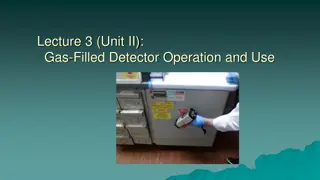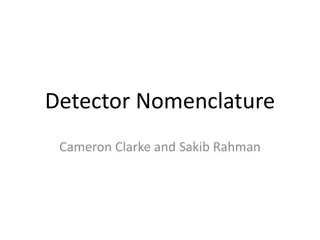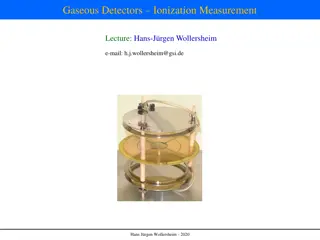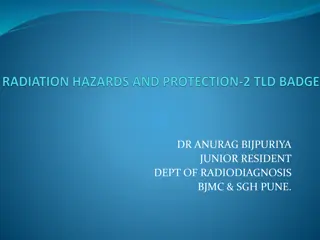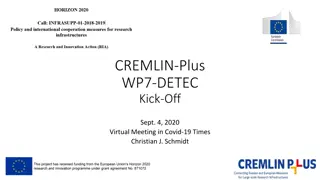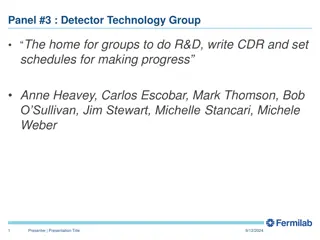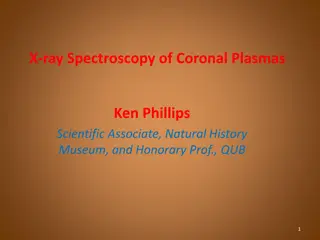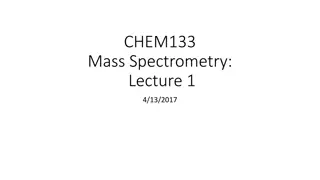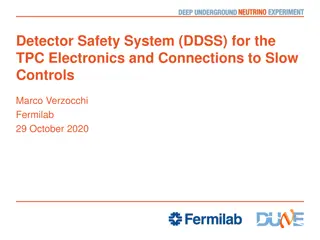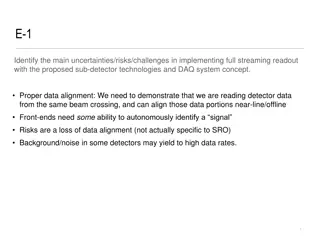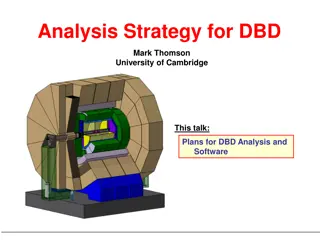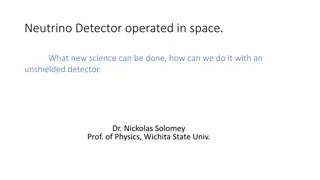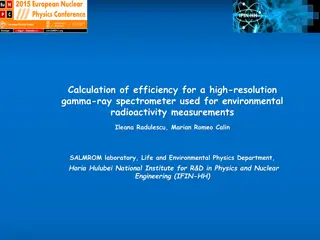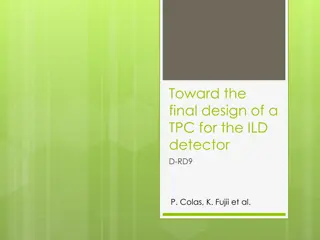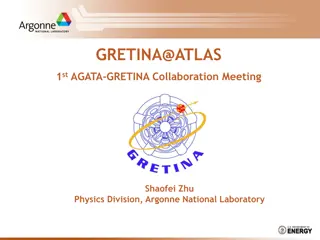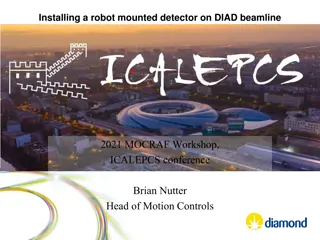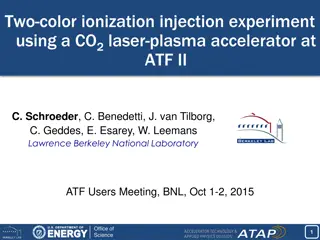ECFA Detector R&D Roadmap and International Collaborations Update
The ECFA Detector R&D Roadmap outlines collaborative efforts in particle physics research, focusing on high-field magnets, muon beams, and more. Task Forces are coordinating community consultations for future experimental programs, with a goal to fulfill strategic needs identified by the ESPP update
0 views • 28 slides
NNbar Annihilation Detector Mechanical Design Proposal
This proposal outlines the mechanical design considerations for the NNbar Annihilation Detector, highlighting practical concerns and proposed changes to the baseline design. Topics cover the structure support, component weights, installation challenges, and optimizations for improved detector perfor
2 views • 27 slides
Gas Chromatography Detectors: Flame Ionization and Thermal Conductivity
Gas chromatography detectors play a crucial role in separating and analyzing compounds in the pharmaceutical field. The Flame Ionization Detector (FID) utilizes hydrogen flame to ionize compounds eluted from the column, while the Thermal Conductivity Detector (TCD) principle involves converting elec
0 views • 13 slides
Gas-Filled Detector Operation and Use in Nuclear Medicine
Gas-filled detectors play a crucial role in nuclear medicine applications. This lecture delves into the operation of a dose calibrator, explaining the radionuclide buttons' functionality and how to determine the appropriate activity of various radionuclides. It also covers the use of ionization surv
0 views • 16 slides
Advanced Detector Nomenclature and Proposed Segmentation System
This content provides detailed information on detector nomenclature, parts, and a proposed segmentation system for advanced spectrometers. It includes visuals and explanations of ring, septant, coil, and segment identification within the detector, offering insights into the intricate workings of spe
0 views • 4 slides
Understanding Temperature Effects on Donor and Acceptor Ionization in Semiconductors
Temperature plays a crucial role in the ionization of donor and acceptor atoms in semiconductors. In N-type semiconductors, the Fermi level lies below the conduction band, while in P-type semiconductors it lies above the valence band, with the position depending on temperature and impurity atoms. Do
1 views • 13 slides
Understanding Ionization of Carboxylic Acids
Carboxylic acids, as proton donors, can undergo ionization to form ions in chemical reactions based on the Brønsted-Lowry theory. Ionization involves the complete loss or gain of electrons, leading to the formation of cations (positively charged ions) and anions (negatively charged ions). Through e
0 views • 13 slides
Understanding Periodic Trends: Atomic Radius and Ionization Energy
The Periodic Table displays a systematic organization of elements based on their increasing atomic number, leading to periodic patterns in their physical and chemical properties. Key trends like Atomic Radius and Ionization Energy provide insights into the size of atoms and the energy required to re
1 views • 13 slides
Closeout Report: Incremental Design Review of EIC Detector Electronics
Closeout report detailing the progress of the Incremental Preliminary Design and Safety Review of the EIC Detector DAQ and Electronics, along with the Final Design Review of Electronics Components for the ePIC Detector. The report includes responses to charge questions, panel reviews, comments, reco
0 views • 23 slides
Neutrino Detectors for NuStorm: Physics Goals and Detector Requirements
Physics goals for neutrino detectors in the NuStorm project include measuring exclusive neutrino cross sections, supporting long baseline programs, searching for sterile neutrinos, and improving measurements. Detector requirements involve reconstructing neutrino interactions, providing charge and pa
0 views • 21 slides
Investigation of Self-Organized Criticality Dynamics in Low Energy Threshold Ionization Detectors
Exploring the effects of energy accumulation in materials in detectors for coherent neutrino scatter, dark matter searches, and superconducting sensors and qubits. Focus on condensed matter effects, responsivity, background, and a hypothesized universal condensed matter mechanism. Touches on energy
0 views • 16 slides
Insights into Gaseous Detectors for Ionization Measurement
Delve into the world of gaseous detectors for ionization measurement, as discussed by Hans-Jürgen Wollersheim. Topics include the Bethe-Bloch formula, ionization detectors, effective ionization energies, charge transport in gas, ion mobility, and electron mobility in gases. Explore concepts such as
2 views • 29 slides
Radiation Detection and Dosimetry in Medical Imaging
Radiation detection and measurement are essential in radiology. Various instruments like ionization chambers, film badges, thermoluminescent dosimeters, and pocket dosimeters are used to monitor radiation exposure. Personnel dosimetry is crucial for tracking radiation doses over time to ensure safet
2 views • 31 slides
WP7-DETEC Kick-Off Meeting: Advancing Detector Technologies for Particle Physics
WP7-DETEC is a collaborative initiative focusing on the development of state-of-the-art detector technologies in the fields of nuclear physics and high-energy physics. The kick-off meeting aims to foster cooperation, exchange ideas, and educate young scientists in the field. Activities include sessi
0 views • 7 slides
Detector Technology Group: Research & Development Strategies
The Detector Technology Group focuses on R&D for detector technology, setting schedules to make progress. Discussions include short-term approaches for describing detectors, collaboration participation, and decision-making. Activities at CERN and Fermilab are reviewed to address any missing R&D area
0 views • 8 slides
Understanding Acids and Bases in Chemistry
Acids donate protons, while bases accept them. Strong acids ionize completely while weak acids only partially ionize, resulting in a Ka value less than one. Water, being amphoteric, can both donate and accept protons. The ionization of water leads to a constant Kw value of 10^-14. Explore the ioniza
0 views • 15 slides
Innovative n-Type Segmented Inverted Coaxial HPGe Detector Study
Comprehensive characterization of an n-type Segmented Inverted Coaxial Point Contact (ICPC) detector by Heather Crawford at the AGATA-GRETINA collaboration meeting. The study focuses on energy resolution, drift time corrections, azimuthal angle and full position reconstruction, along with in-beam ch
0 views • 29 slides
Challenges and Considerations in Electron-Ion Collider Detector Development
Exploring the development of detector systems for Electron-Ion Colliders (EIC) involves addressing various issues such as detector acceptance for low Q2 and high Q2, unique beam characteristics, and the need for specialized components like bend magnets and polarimeters. Key considerations include po
0 views • 16 slides
Communication Strategies and Reports for Advancing Physics Studies and Detector Concepts at EIC
CERN Yellow Reports provide a platform for sharing impactful work related to CERN, including reports on detectors, technical papers, and new activities. The goal is to advance physics studies and detector concepts in preparation for the EIC, focusing on quantifying physics measurements, implications
0 views • 10 slides
Designing Veto Cosmic Ray Detector for JPET Using GEANT4 Simulations
Creating the Veto Cosmic Ray Detector for JPET involves designing the current version of Veto JPET, incorporating 42 scintillators, detecting 4 GeV cosmic muons, generating cosmic muon distribution, and simulating energy deposition inside the veto scintillators. The process includes particle generat
0 views • 26 slides
Understanding X-ray Spectroscopy of Coronal Plasmas in the Solar Corona
Explore the physical properties and ionization conditions of coronal plasmas as revealed through X-ray spectroscopy in the solar corona. Discover how high temperatures and ionization stages impact the equilibrium of elements like Fe, shedding light on the complex nature of these ionized gases. Unvei
0 views • 23 slides
Understanding Detector Response in SIDIS He3 Experiment
Introduction to analyzing hit and occupancy rates from different particle sources in the SIDIS He3 experiment. Explore the simulation data to determine event rates based on detector channels. Examples include pi0 sources and eDIS from the target. Various occupancy cuts are applied, and thresholds ar
0 views • 22 slides
Introduction to Mass Spectrometry: Analytical Chemistry Branch
Mass spectrometry is a vital branch of analytical chemistry, used for qualitative and quantitative analysis of molecular weight, elements, and formulas. It plays a crucial role in identifying compounds and their structures through ionization, separation, and detection of ions by utilizing various te
0 views • 24 slides
Detector Safety System (DDSS) for TPC Electronics and Connections to Slow Controls
The Detector Safety System (DDSS) for TPC Electronics involves multiple protection levels including slow controls, PLC-based systems, and fuses/diodes to ensure detector safety. It's crucial to consider these aspects during the design phase as modifications post-design are challenging. The system, d
0 views • 20 slides
LGAD Consortium for EIC: Advancing Detector Technologies
The LGAD Consortium aims to foster the development of detector technologies based on LGAD sensors for the Electron-Ion Collider (EIC) and future projects. By creating a collaborative effort, sharing expertise, and bringing together those interested in LGAD-based detectors, the consortium seeks to ad
0 views • 9 slides
Challenges and Common Solutions in Implementing Full Streaming Readout for Sub-Detector Technologies
Implementing full streaming readout with proposed sub-detector technologies and DAQ system concept poses challenges including proper data alignment, risks of data loss, and background noise affecting data rates. The transition point for electronic components from detector-specific to common solution
0 views • 9 slides
Development of Silicon Tracker and Sensor Technology for sPHENIX Detector
Research and development efforts are underway for silicon tracker and sensor technology to enhance the functionality of the sPHENIX detector. The project aims to improve mass resolution, cover specific areas effectively, and optimize sensor configurations. Various sensor concepts are being explored
0 views • 25 slides
Analysis Strategy for DBD by Mark Thomson - University of Cambridge
Mark Thomson from the University of Cambridge presented the analysis strategy for the Dual-Beta Detector (DBD) at the ILD Analysis Meeting in Paris, focusing on software models, reconstruction, and validation plans. The strategy includes goals to ensure required physics analyses, develop software mo
0 views • 11 slides
Exploring Neutrino Science in Space with Unshielded Detector - Opportunities and Innovations
The deployment of a neutrino detector in space presents a unique opportunity to conduct groundbreaking scientific research, leveraging the intense neutrino flux closer to the Sun. Key areas of focus include studying rare fusion neutrinos, observing neutrino oscillations during spacecraft transitions
0 views • 11 slides
Efficiency Calculation of High-Resolution Gamma-Ray Spectrometer for Environmental Radioactivity Measurements
SALMROM laboratory at IFIN-HH conducts environmental radioactivity monitoring using high-resolution gamma-ray spectrometry. The system includes a Coaxial p-type HPGe detector with reliable traceability. Activities involve evaluating radon concentrations in various environments and assessing radionuc
0 views • 13 slides
Final Design of ILD Detector TPC - Towards Improved Performance
The final design of a Time Projection Chamber (TPC) for the ILD detector is detailed in this report, showcasing advancements made from 2007 to 2014. The project, D_RD9, focuses on addressing engineering challenges such as electronics, cooling, and software to enhance the TPC's feasibility and functi
0 views • 17 slides
SHMS Detector Commissioning and Installation Updates
Status updates on the commissioning and installation progress of the SHMS detector system, including the noble gas Cerenkov mount optics, mirrors, drift chambers, and various hodoscopes. Details on the system status, high voltage signal cables, DAQ, gas computing, and schedules for detector installa
0 views • 9 slides
Monte Carlo Simulation of GEM-Based Neutron Detector and Detector Performance Analysis
A detailed exploration of Monte Carlo simulations for GEM-based neutron detectors, investigating their detection efficiency and performance characteristics. Various detector designs and concepts, including multi-layer converters and GEM detectors, are discussed, along with simulation results on sign
0 views • 12 slides
Performance Studies of dRICH Detector at ePIC Experiment
The Electron-Ion Collider ePIC experiment focuses on the performance studies of the dRICH detector for particle identification crucial in various physics channels. The detector features aerogel optimization, SiPM sensors, and test-beam analyses. Key capabilities include different techniques for part
0 views • 28 slides
Advances in Nuclear Physics Research at AGATA-GRETINA Collaboration Meetings
Cutting-edge research opportunities in nuclear physics using sophisticated devices like GRETINA at ATLAS, focusing on Coulomb excitation, deep inelastic reactions, and transfer reactions for studying neutron-rich nuclei. The installation of GRETINA involves technical support, equipment upgrades, and
0 views • 20 slides
Installation of Robot-Mounted Detector on DIAD Beamline
Installing a robot-mounted detector on the DIAD beamline for the 2021 MOCRAF Workshop at the ICALEPCS conference. The robot arm holds a diffraction detector for dual imaging and diffraction purposes, ensuring safety for personnel, equipment, and integration into EPICS and GDA systems. Functionality
0 views • 28 slides
Overview of SiD Workshop Summary and DBD Planning
The SiD Workshop at the University of Oregon in November 2010 focused on the Summary of DBD Planning by Andy White. Key points covered included the timeline from Fall 2007 to End 2012, the Detailed Baseline Design DBD with nine crucial points, guidance for DBD presenters, and the importance of final
0 views • 29 slides
Two-Color Ionization Injection Experiment Using CO2 Laser-Plasma Accelerator
This experiment conducted at ATF II focused on generating beams with ultra-low transverse emittance utilizing two-color ionization injection with a CO2 laser-plasma accelerator. The technique involves using a pump laser pulse in circular polarization and an injection laser pulse in linear polarizati
0 views • 15 slides
Understanding the Titration of Weak Acids and Amino Acids
Titration is a crucial technique used to determine the properties of weak acids and amino acids. This process involves calculating pH values, degree of ionization, and understanding the ionization equilibrium of different acid-base systems. Various examples, including glycine hydrochloride, isoelect
0 views • 15 slides
Understanding Acids and Bases: Ionization and Properties
Acids donate protons while bases accept them. Strong acids and bases ionize completely, while weak acids ionize partially. Water is amphoteric, capable of both accepting and donating protons. The equilibrium constant Kw for water is 10^-14. Understanding the ionization of weak acids and weak bases h
0 views • 15 slides



